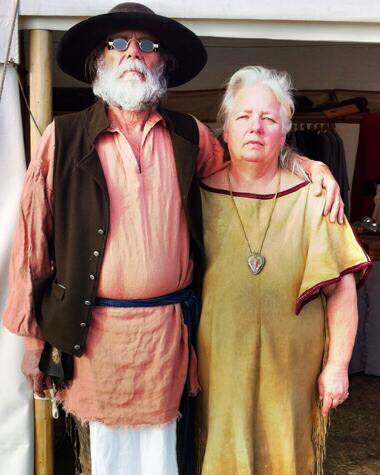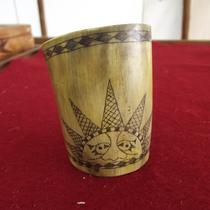| ||||
|
|
Our Products: Portmanteau Bags Clothing Scrimshaw Leather Bound Books Cook and Table Ware Miscellaneous Items Foot-Ware Carpet Bags Turtle Neck Bags Wallets Sketch Books Journals Moccasins Custom Leather Cloth... Wolf Ear Hoods Pommel Bags Our Red Carpet: View Calendar Happy Customers Wish Lists Reviews Articles & References: Rendezvous Clothing Guide Fur Trade Era Cooking Rendezvous Glossary The Rendezvous Experience Rendezvous History Helpful Links |
|||||||||
|
|||||||||
|
We Accept:
|
|||||||||
Follow us on our Journey:
|
|||||||||
Rendezvous Glossary
Typical Terms of Rendezvous Equipment
See also:Typical Terms of Rendezvous Expressions
Typical Terms of Rendezvous Clothing
To aid you in deciphering the mysteries of Rendezvous vocabulary, we have provided the following definition of commonly used terms:
- A Twist (a twist): Rolled tobacco leaves that are twisted. This can be broken and put into his pipe or can be chewed by the mountain man.
- Arkansas Toothpick (Ar-kan-sas tooth-pick): A large, pointed dagger used mostly by river men.
- Ball (ball): Round piece of lead that is pushed down the barrel; Bullet. (The actual projectile.)
- Big Fifty (big fif-ty): The .50 caliber Sharps rifle used by the buffalo hunter.
- Blunderbuss (blun-der-bus): A firearm with a short, large caliber barrel which is flared at the muzzle and frequently throughout the entire bore, and used with shot and other projectiles of relevant quantity or caliber.
- Caplock (cap-läk): A general term for any firearm that uses a percussion cap ignition mechanism.
- The Cock (the cock): The hammer of a rifle or pistol.
- The Cone (the cone): The nipple on a percussion rifle or pistol.
- Du Pont (du pont): Gunpowder.
- Dutch Oven (duch-uv-en): A thick-walled cast iron cooking pot with a tight-fitting lid.
- Flat Boat (flat boat): A large scow used to float up to three tons of fur and skins to St. Louis.
- Flintlock (flint-läk): A general term for any firearm that uses a flint striking ignition mechanism.
- Float Stick: (float stick): A stick attached to a steel trap used to show the location of the trap and the trapped animal. From this comes the expression, "That's the way my stick floats" , meaning , " That's the way I feel about it."
- Galena Pill (ga-lee-na pill): Lead balls (bullets).
- Galena (ga-lee-na): Lead.
- Green River (green riv-er): The hilt of a knife (from the old GR trade mark up near the hilt). A knife made by Russell Green River Works. A copy of a Russell Green River Works knife, A western river that has its head waters in the Uinta Mountains of Utah/Wyoming.
- Hawk (hawk): Short for "Tomahawk".
- Hawkin (Haw-kin): Refering to a popular rifle made by Samuel Hawkin in St. Louis around 1840.
- Inkle Loom (ing-kal-lum): A simple narrow device used for weaving long decorative bands and belts.
- Keel Boat (keel boat): A 60 to 80 foot long flat-bottomed boat about 16 feet wide. In wide use before steamboats. It is powered by men rowing or by wind with a sail and mast. Used by Lewis and Clark going up the Missouri River.
- Kyack (Kyack): A rawhide box designed to be strapped to a pack saddle.
- Lancaster (Lancaster): Another popular rifle, produced in Lancaster, Pennsylvania from the 1770's-1790's. Also known as the "Kentucky Rifle" made popular by Daniel Boone. It was also one of the many styles of rifle carried by Lewis and Clark (1804-1806).
- Lash Rope (lash rope): The rope used to tie a load to a pack saddle.
- Leman (Leman): A true plains rifle made by Henry Leman during the 1850's-1860's. This rifle looks similar to the Hawkin.
- Lodge (lodge): The living quarters be it house, cabin, tipi, hogan, tent, or lean-to, of the Indian or mountain man.
- Lucet (Loo-cet): A tool used in cordmaking or braiding used to create cords that were used on clothing.
- Mackinaw (mackinaw): A boat approximately 40 feet long, 10 feet across the beam, and 4 feet deep, pointed at both ends. This boat, widely used on the Mississippi, Missouri, and Ohio River systems, was capable of holding a cargo of approximately 10 tons. Often these were used for downstream travel only.
- Medicine Bag (medicine bag): The small bag, used to carry the medicine of the Indian. Adopted by the mountain man and used to carry anything small, especially the "secret" bait he used near his traps.
- Medicine (medicine): Bait or smell from the caster glands of the beaver or another animal carried in a small bottle contained in the medicine bag that masks the scent of the iron and brings the animal to trap.
- Moccasin (moccasin): The buckskin or moose hide shoe of the Indian and mountain man. Light, quiet, and comfortable.
- Muzzleloader (muz-zle-lod-er): Any firearm into which the projectile and usually the propellant charge is loaded from the muzzle/barrel of the gun.
- Parfleche (parfleche): Rawhide made from buffalo hide. It is exceedingly tough. In fact, its name (French) comes from the fact that it could not be pierced by arrows or spears. The word also refers to a carrying case or envelope made of dried buffalo hide and widely used by both Indians and mountain men in place of a trunk.
- Pipe (pipe): The jornada or smoking tool of the mountain man. The distance between rest stops, which were the only times his pipe could be lit up and enjoyed.
- Ponche (ponche): Trade tobacco.
- Portmanteau (pôrt-man-to): A large trunk or suitcase, typically made of stiff leather and often opening into two equal parts.
- Possibles (pos-si-bles): The personal property of the mountain man, Such items as a bullet mold, an awl, knives, a tin cup, his buffalo robe or a blanket capote, his pipe and tobacco, flint and steel, sometimes a small sheet-metal fry-pan, and other accouterments he considered necessary. Firearms were considered "pieces" or guns" and not possibles.
- Possibles Bag (possibles bag): What ya keep yer possibles in, such as fire steel, caps, wallet, coin of the realm, etc. In the bag or pouch were hung on the bags shoulder strap. Shooting needs were given first priority, kept where they could be found with ease and speed.
- Rawhide (rawhide): The dried, dehaired but untanned hide of any animal, usually cattle or buffalo. Very strong and useful.
- Tomahawk (täm-a-hôk): A type of single-handed axe native to the many Indigenous peoples and nations of North America, traditionally resembling a hatchet with a straight shaft.
|
||||||||||
|
||||||























